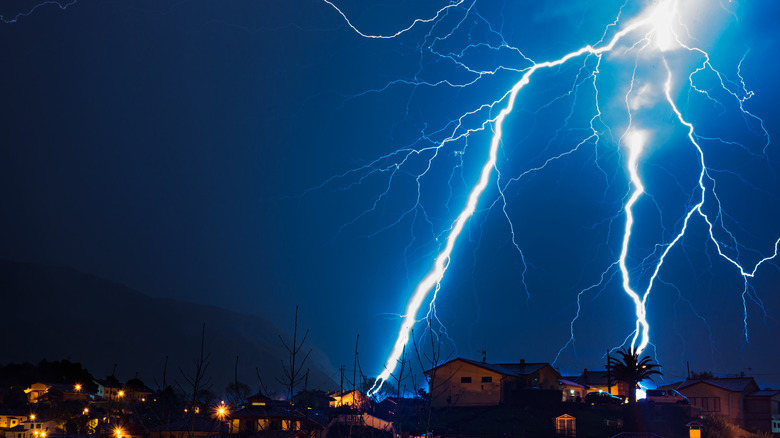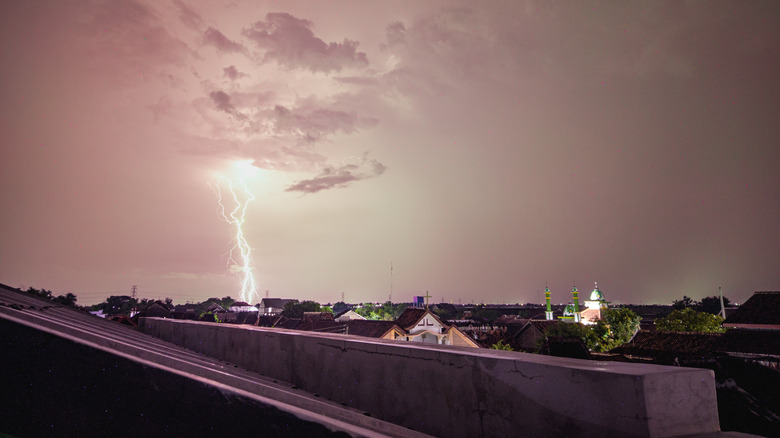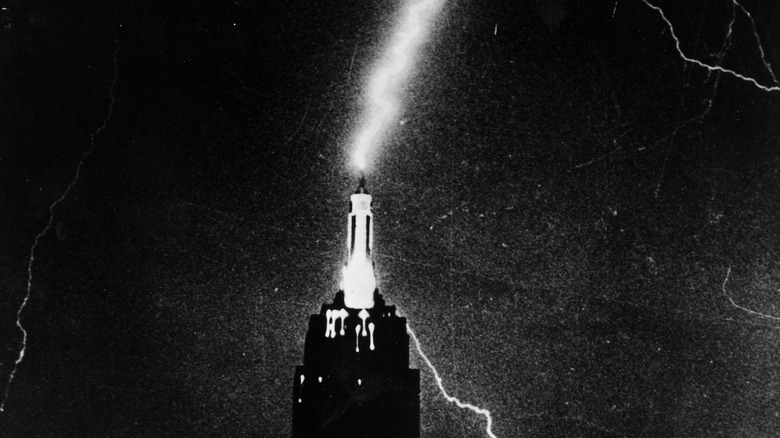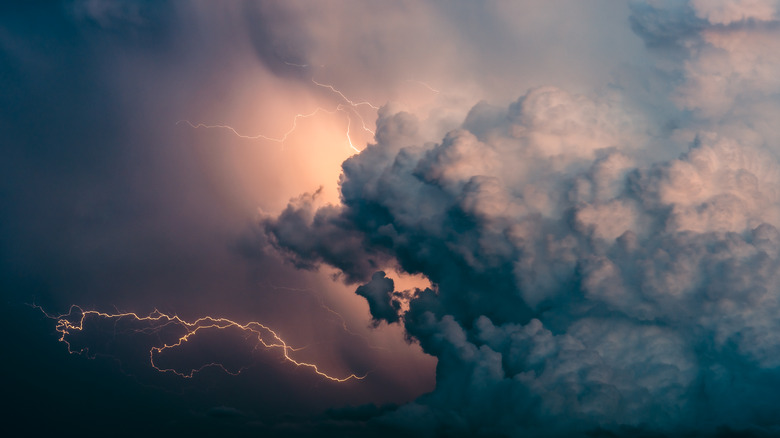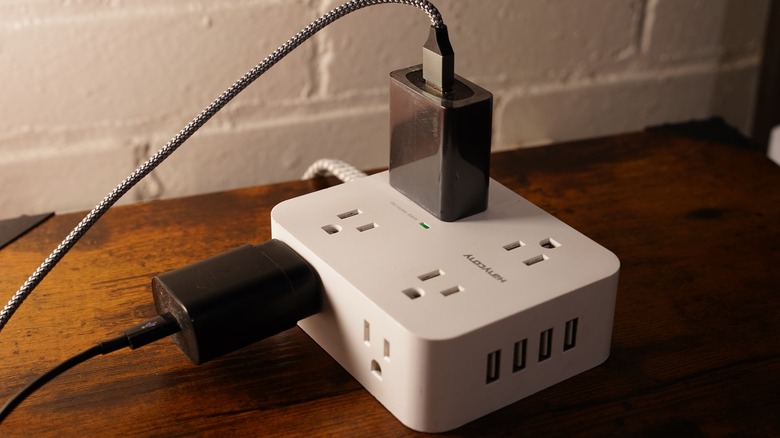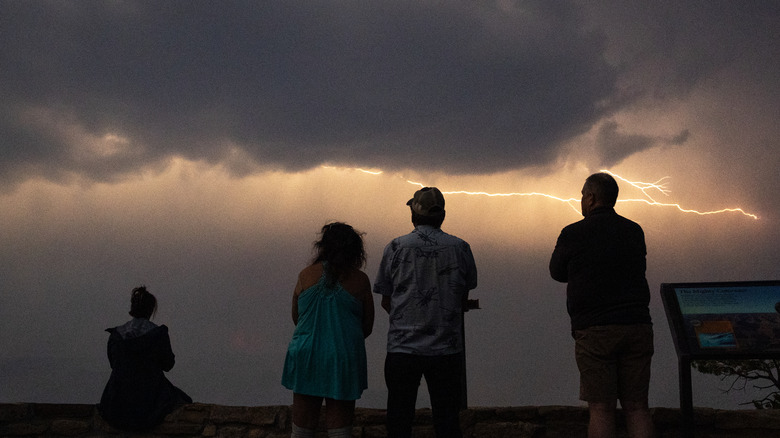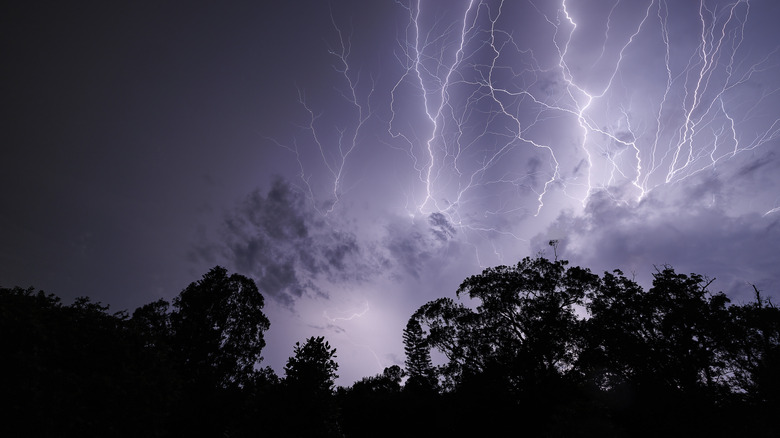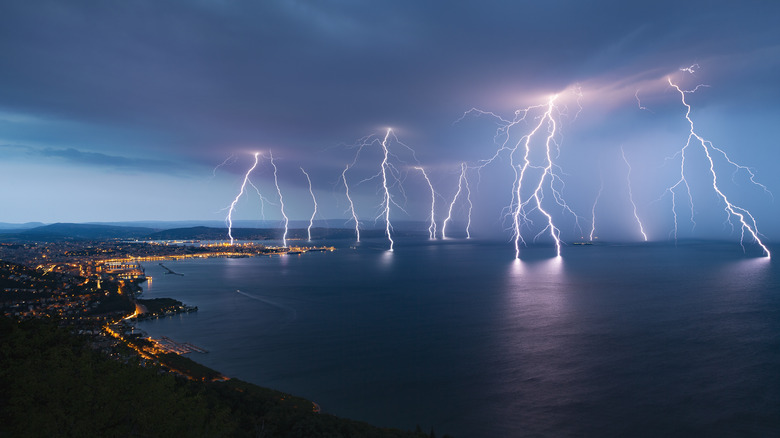Stop Believing These 14 Myths About Lightning
It's pretty safe to say that lightning is one of nature's most dramatic and fantastic displays of power. But, thanks to its commonality and frequency — who hasn't seen a lightning strike before, after all — lightning has more than a few myths behind it that hurt more than help, especially if you're caught in its crosshairs. From where it strikes to the signs it's coming, there are more old wives' tales out there that completely get it wrong, and taking their advice can end up being a fatal mistake.
That's why it's quite useful to break down 14 of the most common myths you've probably heard about lightning and see the science behind why you should consider them debunked. There's no harm in separating that fact from fiction and learning just how following some of these could actually put you in harm's way more than if you did the opposite. It's time to set the record straight and rethink everything you thought you knew about lightning, so kick off your rubber-toed shoes, step away from that surge protector, and let's talk about the ways you can stay safe during a lightning storm.
Lightning never strikes twice in the same place
The adage that lightning never strikes twice in the same place may make a good proverb, but it's just scientifically incorrect. Lightning does, in fact, strike the same spot repeatedly, especially if that spot is tall, pointy, and isolated. It comes down to physics: Lightning wants to take the path of least resistance, and the quickest route could often be a mountain peak, sky scraper, or even your head popping out of the water. The Empire State Building in New York City is not only one of the best buildings to build for school projects, but was once used as a so-called "lightning laboratory" thanks to it being hit nearly 25 times per year and up to a dozen times in a single storm.
So, how did this myth even come about? Most likely, it was more an analogy for comforting someone in the middle of a bad luck streak rather than to be taken as a scientific fact. While it might help someone realize that bad luck eventually ends, environmental factors like geography and atmospheric pressure make it something you shouldn't base your rainy day activities around. Just look at Florida's "Lightning Alley," the corridor from Tampa Bay to Titusville, which receives the more lightning annually than anywhere else in the U.S.
Lightning only strikes the tallest objects
While it's true that lightning will take the path of least resistance, the idea that it only targets the tallest object around is a dangerous oversimplification. Yes, lightning often will hit the tallest object around, particularly if that thing is the only thing in a sea of flat land. However, lightning is indiscriminate and will happily hit anywhere it can, tall buildings or otherwise. Lightning has been known to strike the ground in an open field even if there is a tree line close by, or bypass a building to strike a car in the parking lot nearby.
It's probably pretty clear to see how this myth most likely started: Tall objects are often near populated areas, so we're bound to see it striking taller, man-made objects, than we would notice a bolt coming down in a wide, open field. The truth is, though, that there are multiple factors that influence a lightning strike. Air temperature, electrical charges in the air, types and amounts of precipitation – it's all behind where a lightning bolt forms and how it makes contact with our planet. So, don't believe you're safe because you're surrounded by skyscrapers; it's a gamble that's not worth the stakes.
Being under a tree is safer than no shelter during a thunderstorm
The idea of sheltering under a tree during a thunderstorm can be deadly, and in fact, it may be one of the worst things you can do. While it's true that a tree's height makes it a prime target for a strike, a ground charge can spread from the trunk in all directions. Standing under the tree means you're both at risk for having this charge travel through you as well as in danger from any branches or falling debris. But the ground charge is the more worrying variable, as it's the second leading cause of lightning casualties.
This myth most likely comes from what seems like common sense: If you hid under a tree's canopy, then it stands to reason it could act as a cover that takes the brunt of the strike, especially if it has a thick canopy. But the tree's ability to act like a lightning rod that conducts the electrical charge to the ground — and you — make it incredibly dangerous. Interestingly, a 2025 study in New Phytologist found that the species Dipteryx oleifera may have even evolved to use lightning's tendency of creating open spaces in the canopy to its advantage. So, don't run for that tree to use as shelter, especially if safer options like buildings or hard-topped vehicles are available.
If you don't see rain or clouds, you're safe from lightning
The myth that a lack of rain or clouds means less chance of lightning is a dangerous and deadly one. The truth is that lightning can, and often will, strike more than 3 miles from its "parent" storm, even if there's no rain or thundercloud in sight. And while it's rare, there are also what's known as "bolts from the blue," or strikes that happen in clear blue skies as much as 10 to 20 miles away from the thunderstorm.
This myth most likely comes from another idea that seems like common sense: If you can't see a thunderstorm, then what are the chances you'd get struck by lightning? While the science shows the chances are rare, they're not zero. In reality, lightning can travel horizontally from a cloud's top before finally arcing down to the ground. So, if you can hear thunder in the distance, take that as your sign to seek shelter ASAP, because you're most likely in range of a lightning bolt's arc.
Rubber tires on a car protect you from lightning
A car's rubber tires acting as insulation against lightning strikes is a common, but misleading, myth. There is a little bit of truth to the concept, though, because hard-topped vehicles can offer significant protection from lightning during a thunderstorm, but the rubber tires have little to do with it. The actual protection is due to the metal body of the car and roof acting like a Faraday cage. If the car is struck by lightning, the current moves around the exterior "shell" until it finds its way to the ground. The people inside the car, therefore, remain unharmed.
The myth that rubber tires are the thing that protects people from lightning probably comes from a misunderstanding of how electrical conductivity works. Yes, rubber acts as an insulator against electrical currents, but the millions of volts that come through a lightning bolt overwhelm any safety rubber might provide. This is also why hard-covered vehicles are key; convertibles, soft-top Jeeps, bikes, and motorcycles offer no lightning protection since they have no way to channel the current around the passengers. So, next time a storm rolls around, the rubber can hit the road, but it's the hard top of your car that's the true hero.
Wearing sneakers can protect you since rubber is a poor conduit
Thinking that the rubber soles of your sneakers can keep you safe on your run through a thunderstorm can be a dangerous misconception. While it's true that rubber is a poor conductor of electricity, the millions of volts from a lightning bolt are more than enough to override that poor conductivity. It's like trying to plug a firehose with a wine cork; the immense force pushing against the rubber, or cork, make any protection or blocking properties it has moot.
The idea that sneakers or rubber boots can keep you safe most likely stems from the fact that rubber can insulate against electric currents. The problem is that it forgets the sheer magnitude of electricity behind a lightning strike. Even if your shoes could theoretically offer some electrical resistance, there are other variables at play you'll need to consider. For one, if any other part of your body is touching the ground, like your elbow or knee, the current can flow through there. Also, if you're running in a thunderstorm, then you're most likely in contact with water, which is an excellent conductor of electricity, causing you to become grounded and completing the electrical circuit, circumventing your shoes. Instead of risking it, stay inside or get into a hard-topped vehicle ASAP, where the metal shell can safely conduct the electrical current away from you.
Being in a swimming pool during a thunderstorm increases your chances of a lightning strike
There's a common belief that a swimming pool can somehow attract lightning, which is not entirely accurate. It's not that the water in the pool itself attracts lightning, but rather that its conductivity can be deadly. Water is an excellent conductor of electricity, and the current that comes from a flash of lightning has the strength to travel through it for long distances. So, while the pool of water itself doesn't act like a magnet, if a bolt hits the water or even the ground close enough, the voltage can spread rapidly through the water.
This myth most likely stems from a misinterpretation of how electricity travels through water. Yes, any body of water can be incredibly dangerous during a thunderstorm thanks to how quickly it can spread the current through its depths. But the danger isn't about the water attracting the bolt, but about what happens to whatever is in the water should a bolt hit nearby. That's why it's typically recommended to get out of any body of water, including off beaches and piers, immediately once you hear thunder. If you cannot get out of the water, like if you're on a boat or raft, get into the deepest part you can, get under a shelter, and do not touch anything metal or electrical until the storm passes.
Lie flat on the ground during a thunderstorm to protect yourself
The idea that hitting the deck, so to speak, and lying flat on the ground can protect you from lightning is a deadly myth and is most likely the worst thing you could do. When lightning strikes, its current spreads horizontally in all directions, so putting as much of your body into contact with the ground drastically increases your chances for getting shocked thanks to adding more potential contact points for the current to enter. Plus, since lightning looks for the path of least resistance, your body is slightly higher than the ground, making you closer to the charged air and an easier target.
This myth probably stems from the incorrect idea that lightning will always strike the tallest thing around, so your whole body being closer to the ground means you're less likely to be said tallest object. The problem is that in outdoor settings, the danger from lightning isn't just about a direct hit but the ground current, too. Once the bolt hits the ground, the current moves quickly. When it reaches your body, you become part of the circuit, and tissues that have lower resistance — nerves, blood vessels, skin, etc. — transmit that current. Skin, specifically, loses its resistance when wet and can significantly alter the current's flow and the amount of heat generated, causing burns. If you're caught off-guard outside during a thunderstorm and cannot seek shelter, the best way to protect yourself from lightning is to crouch low with your feet together and try your best to keep as many parts of your body off of the ground as you can.
Touching a lightning strike victim will electrocute you, too
The idea that you shouldn't help a lightning strike victim as a way to keep yourself safe is a dangerous myth that can cost someone their life. Lightning strike victims do not carry an electrical charge and are perfectly safe to touch. Once a person or animal is struck, the current passes through them and dissipates almost instantly. Unfortunately, waiting too long usually means losing critical time to render aid to a victim and can have fatal consequences.
The idea that strike victims are electrically charged probably comes from a misunderstanding of how long the body traps the electrical current. Let's be clear: lightning strike victims do not carry an electrical charge after the strike and need immediate medical attention. First, make sure the area is safe for yourself and call 911. Once you've established it's safe to proceed, begin CPR if the person has stopped breathing or if you can't find a pulse. Every second counts, so the sooner you can help deliver life-saving aid, the more likely the chance they'll survive.
Wearing metal attracts lightning
Some people prefer to be safe rather than sorry, but the idea that wearing metal jewelry, belt buckles, etc., would act like a magnet for lightning is a myth. The truth is, the amount of metal you're wearing will make very little difference where lightning will strike. Instead, what matters more are the height of the metallic object, how sharp the object is, and how isolated it is. Lightning seeks the path of least resistance to the ground and your watch or necklace, though it's most likely fabulous, isn't enough by itself to attract lightning's attention.
However, there is some truth to this myth. While metal doesn't necessarily attract a strike, it is an excellent conductor of electricity. So, if lightning does happen to strike something metallic that you're touching or are very close to, like a metal fence, pole, or even plumbing, the electricity can instantly travel through that metal and electrocute you, even if the actual contact point where lightning struck is some distance away. So, you don't need to chuck that engagement ring or nose piercing during a thunderstorm, but you should prioritize going inside or seeking shelter instead.
Surge protectors will stop electrical surges from happening
Relying solely on surge protectors to keep your electronics safe from lightning is a dangerous misconception that many find out about the hard way. While surge protectors can protect against everyday power fluctuations or minor surges, lightning simply generates way too much of a surge for it to handle, even if the strike doesn't directly hit your house or apartment building. To give you an idea of the disparity, a single bolt of lightning can generate up to 1 billion joules of energy while the average surge protector rated for expensive electronic protection taps out around 1,000 joules.
The belief that surge protectors can protect against lightning strikes probably came about from a misunderstanding of their capabilities, and some manufacturers never bothering to correct the error. Your best method for protecting your devices is to install both a surge protector and a grounding network — also called a lightning protection system. This one-two punch provides a pathway for the electricity from a lightning strike to divert into the ground instead of your fuse box. Also, regardless of the system you have, do not unplug electronics during a lightning storm; there's a risk you could be struck by lightning before the circuit is broken.
Thunder can occur without lightning
The idea that thunder can occur without lighting is a total myth because thunder is a result of lightning. When a lightning bolt flashes, it superheats the air around it to an incredible 50,000 degrees Fahrenheit (to give some context, the surface of the sun is a "measly" 10,000 degrees Fahrenheit). That burst of heat causes the air to expand outwardly in a rush that generates a shockwave, which is what we hear as a thunderclap. So, wherever there's thunder, there is most definitely lightning.
This misconception could come from the times when you see lightning but don't hear that iconic clap of thunder (different than the rolling thunder you might hear at other times). This phenomenon is called "heat lightning" and typically occurs when you can see the lightning bolt, but it's actually too far away — around 10 miles — for its shockwave to travel all the way to your ears. So, if you hear that rumble that means lightning is nearby and it's a good idea to seek shelter immediately.
Lightning only happens during thunderstorms
It's easy to assume that lightning and thunder are a consistent pair, but that's a myth thanks to an interesting quirk in precipitation. While most lightning does tag team with thunderstorms, there's also what's known as "dry lightning," and knowing about it can save your life. Dry lightning can be a serious threat since it doesn't require a significant rainfall and can catch people by surprise.
Dry lightning happens when there's enough precipitation to cause a thunderstorm but the rain evaporates before hitting the ground. This is what makes it so dangerous, as a burst of electricity without moisture can cause forest fires. Dry lightning is also insidious because it can strike miles away from the thunderstorm you see in the distance. So, don't get too comfortable if you see a storm in the distance. Remember that lightning can travel up to 20 miles from its parent storm, so play it safe and seek shelter immediately.
Climate change increases the likelihood of lightning
It might seem intuitive that our changing climate, with its increasingly raging storms, means that we should expect more lightning strikes in our future. However, this idea is still a subject for debate and, as of this writing, has no definitive answer. So, if someone tells you our warming planet unequivocally means we're in for lots of lightning, ask them for a few sources.
There are many factors that cause lightning strikes to happen, and so-called "superbolts" are still not scientifically accepted as fact. It's true that a warmer atmosphere holds more moisture and energy, which fuels thunderstorms. But, it's also true that the rising atmospheric moisture could cause the electrical charging zone to form higher up, thereby decreasing the number of strikes that make it to the ground. It's a complex puzzle that, unfortunately, we'll need to wait to see how it plays out before we know whether we're in for more lightning or less.
